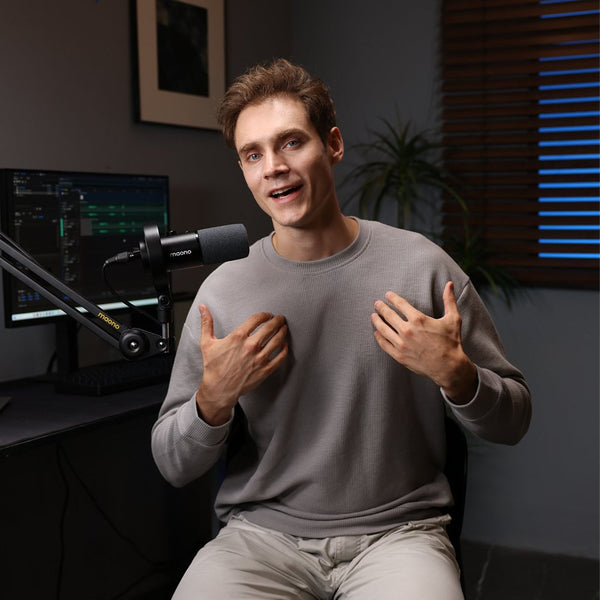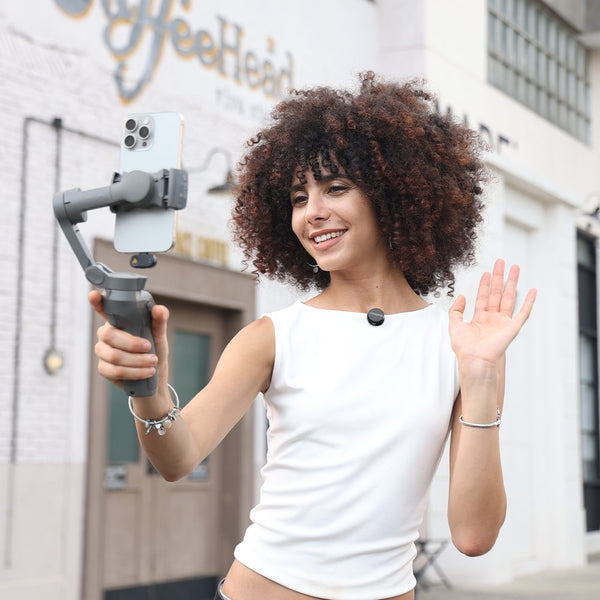Ever noticed influencers filming themselves while walking? Athletes do this too, often vlogging their walking and exercise routines. But what benefits do people really get from walking? Is using a wireless microphone really necessary for vlogging your walks? Let’s find out—keep reading.
Walking videos have exploded in popularity on platforms like YouTube, TikTok, and Instagram. Whether it’s a solo vlog, a walking interview, or a travel documentary, the combination of movement, scenery, and conversation creates an immersive viewer experience. But there’s a key ingredient that separates an amateur walking video from a professional-looking one—audio quality.
Poor audio can ruin even the most visually stunning footage. That’s why creators, journalists, fitness coaches, and street interviewers are turning to wireless microphones. They offer mobility, freedom from tangled cables, and—most importantly—crisp, clear sound even when you’re moving. For beginners and pros alike, investing in a wireless microphone for mobile recording can be a game changer, especially when filming on a smartphone while walking..
In this guide, we’ll explore how walking with a wireless mic not only improves sound but also enhances storytelling, boosts video engagement, and even benefits your health. If you’re searching online for a wireless microphone nearby or checking “wireless microphones near me” before your next shoot, you’ll find this breakdown helpful.
How Walking with a Wireless Mic Can Improve Storytelling
When you walk and talk, your environment becomes part of your story. The sound of footsteps on gravel, birds in the background, or distant city chatter all add layers of authenticity.
With a microphone wireless system, you can capture your voice clearly while still allowing subtle ambient sounds to come through—without overpowering your speech. This balance keeps viewers engaged and feeling like they’re walking alongside you.
More importantly, walking allows for natural storytelling flow. The movement can reflect your narrative’s rhythm, whether you’re delivering travel tips, sharing a personal story, or conducting an outdoor interview.
How Wireless Mics Improve Sound Quality for Outdoor Walking Videos
Outdoor filming comes with challenges—wind, traffic noise, inconsistent distances from the camera. A wireless microphone and transmitter setup solves these issues by keeping the microphone consistently close to your mouth.
Instead of relying on your camera’s built-in mic (which picks up everything in the environment), a wireless mic captures your voice with directional clarity. Many models also have built-in noise reduction, so background chaos won’t drown out your message.
This makes a huge difference in sound quality, especially when shooting in busy streets, parks, or tourist spots.
Top Benefits of Using a Wireless Mic While Walking and Filming
Interestingly, walking with a wireless mic isn’t just about better audio—it can also positively impact your health and delivery on camera.
1. Increased blood flow or circulation
Walking gets your blood pumping, which improves oxygen flow to your brain. This makes you more alert and energetic, translating into a more lively performance for your viewers.
2. Improves the mood
Physical activity releases endorphins. If you’ve ever noticed you’re more cheerful after a stroll, that’s the science at work. Happier presenters are naturally more engaging.
3. Reduces cortisol levels
Walking lowers stress hormones. This means you’ll come across calmer and more confident on camera, especially during live streams or first-time recordings.
4. Lowers the blood sugar level
Short walking sessions after meals help regulate blood sugar. If you film lifestyle or health content, this is a bonus worth sharing with your audience.
5. Reduces likelihood of overthinking
Walking helps clear mental clutter. This can prevent over-rehearsing or sounding stiff—your delivery will be more natural and conversational.
Tips for Capturing Clear Audio While Walking and Talking
-
Position the mic correctly – Clip it near your mouth, but not directly under your chin to avoid breathing sounds.
-
Use a windscreen/windproof or deadcat – A small foam or furry cover dramatically reduces wind noise.
-
Check your levels before filming – A quick test ensures you’re neither too loud nor too soft.
-
Walk at a steady pace – Sudden movements can cause clothing rustle or mic bumps.
-
Mind your environment – Avoid filming too close to loud engines, construction, or heavy crowds unless that sound is part of your story.
How to Avoid Wind Noise and Background Sounds When Walking
Wind can be the nemesis of outdoor audio. Even a light breeze can sound like a hurricane through a microphone. Here’s how to combat it:
-
Use a wind muff (also called a deadcat/windproof) over the mic capsule.
-
Turn your body so your mic is shielded from direct wind gusts.
-
Select a mic with noise-canceling features for outdoor use.
-
Adjust mic sensitivity to minimize faraway sounds.
-
Avoid open, exposed areas when possible—walk near buildings or trees for natural wind barriers.
Best Wireless Microphones for Vlogging While Walking
Not all wireless mics are created equal. For walking videos, you need something lightweight, portable, and reliable with stable connectivity.
1. Maono Wave T5 Wireless Microphone

The Maono Wave T5 offers long transmission range and excellent sound clarity, making it perfect for outdoor creators. Its lightweight build ensures you won’t feel weighed down, and the stable wireless signal prevents dropouts even if you walk a good distance from your camera.
Notable features:
-
Up to 300m transmission range
-
Low-latency audio transmission
-
Built-in noise cancellation
-
Long battery life (up to 10 hours)
2. Maono Wave T1 Mini Wireless Microphone

If you want something even smaller, the Maono Wave T1 Mini is ideal. It clips discreetly onto clothing and works great for smartphone vlogging or action camera setups.
Notable features:
-
Ultra-compact size
-
Easy plug-and-play pairing
-
Windproof mic cover included
-
360° omnidirectional pickup pattern for consistent sound
Both options deliver freedom of movement while ensuring professional-grade audio—exactly what you need for engaging walk-and-talk videos.
FAQs:
1. Why do people enjoy watching walking videos?
Walking videos create a feeling of companionship and immersion. Viewers feel like they’re exploring alongside you, experiencing real-time sights and sounds.
2. What are the main advantages of using a wireless mic for walk-and-talk videos?
Mobility, consistent audio quality, and freedom from tangled cables.
3. How does a wireless mic improve audio quality while filming outdoors?
It stays close to your mouth, reduces background noise, and avoids volume fluctuations caused by moving away from the camera.
4. What type of wireless mic works best for walking and vlogging?
Lavalier-style wireless mics are lightweight, discreet, and perfect for mobile filming.
5. Can a wireless mic reduce wind noise when walking outside?
Yes, especially if paired with a windscreen or deadcat.
6. How far can I walk from my camera while still getting clear audio?
Many wireless mics work reliably up to 100–200 meters.
7. Are there lightweight wireless mics suitable for long walking sessions?
Yes, compact lavalier systems like the Maono Wave T1 Mini are great options.
8. How do I prevent audio dropouts while moving?
Stay within the mic’s recommended range and avoid obstacles between transmitter and receiver.
9. What’s the difference between using a lavalier and a shotgun mic while walking?
Lavalier mics clip to your clothing and move with you; shotgun mics stay on the camera and work best when you’re facing it.
10. Does walking with a wireless mic make editing easier?
Yes—consistent audio means less time fixing volume levels in post-production.
11. How can a wireless mic help with hands-free filming?
It eliminates the need to hold a mic, allowing you to focus on framing your shot.
12. What are some tips to keep consistent volume while walking?
Keep the mic in the same position and speak at a steady tone.
13. How do I set up a wireless mic for walking interviews?
Clip a lavalier mic on each person and connect them to a dual-channel receiver.
14. Can I use a wireless mic with my smartphone while walking?
Yes—many models, including Maono Wave mics, have smartphone adapters.
15. What battery life should I expect from a wireless mic during walks?
Typically 6–8 hours, depending on the model.
16. How do I protect my wireless mic from sweat or moisture?
Use a small plastic shield or position the mic slightly away from skin contact.
17. What’s the best way to hide or clip a wireless mic when walking?
Under a jacket lapel or shirt collar for discretion, ensuring it’s not rubbing against fabric.
18. Are there affordable wireless mic options for beginners filming while walking?
Yes—entry-level models like the Maono Wave T1 Mini offer great value.
19. How do I sync wireless mic audio with video in post-production?
Clap once before starting; use that spike in your waveform to align tracks.
20. Can wireless mics work well in busy city streets while walking?
Yes—choose a model with strong noise suppression to handle ambient sounds.
Final Thoughts
Walking and filming outdoors is one of the most engaging ways to connect with an audience. It blends storytelling, movement, and environment in a way that static filming can’t match. But to make it work, clear audio is essential—and that’s where a good wireless mic comes in.
Whether you choose the Maono Wave T5 for its range and professional features or the Maono Wave T1 Mini for its portability, both will help you deliver content that sounds as good as it looks. So next time you’re searching for a wireless microphone nearby or browsing options for a microphone wireless system, you’ll know exactly what to look for–the go-to-place is Maono.
Grab your mic, take that first step, and start walking your way to better videos.



